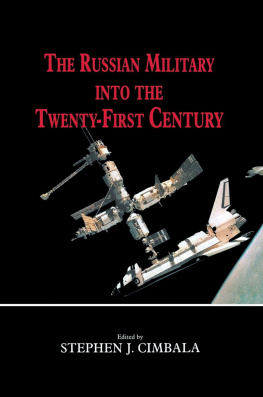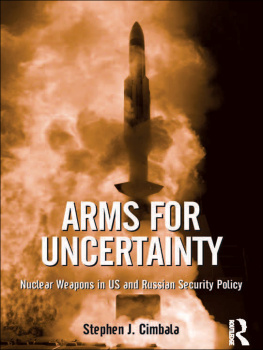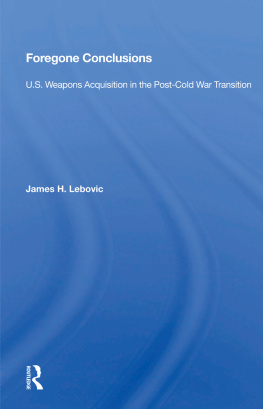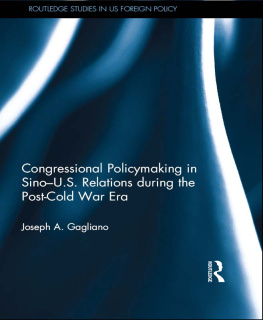Cover
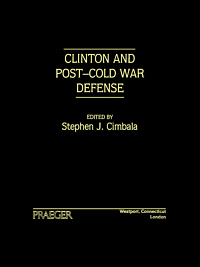
| title | : | Clinton and Post-Cold War Defense |
| author | : | Cimbala, Stephen J. |
| publisher | : | Greenwood Publishing Group |
| isbn10 | asin | : | 0275950069 |
| print isbn13 | : | 9780275950064 |
| ebook isbn13 | : | 9780313046469 |
| language | : | English |
| subject | United States--Defenses, United States--Politics and government--1993-2001, Defence (Military strategy)--Policies--Of--Government , United States |
| publication date | : | 1996 |
| lcc | : | UA23.C564 1996eb |
| ddc | : | 355/.033073 |
| subject | : | United States--Defenses, United States--Politics and government--1993-2001, Defence (Military strategy)--Policies--Of--Government , United States |
Page i
Clinton and Post-Cold War Defense
Page ii
This page intentionally left blank.
Page iii
CLINTON AND POST-COLD WAR DEFENSE
EDITED BY
Stephen J.Cimbala

Page iv
Library of Congress Cataloging-in-Publication Data
Clinton and post-Cold War defense/edited by Stephen J.Cimbala.
p. cm.
Includes bibliographical references and index.
ISBN 0-275-95006-9
1. United StatesDefenses. 2. United StatesPolitics and
government1993 I. Cimbala, Stephen J.
UA23.C564 1996
355'.033073dc20 9530659
British Library Cataloguing in Publication Data is available.
Copyright 1996 by Stephen J.Cimbala
All rights reserved. No portion of this book may be
reproduced, by any process or technique, without the
express written consent of the publisher.
Library of Congress Catalog Card Number: 95-30659
ISBN: 0-275-95006-9
First published in 1996
Praeger Publishers, 88 Post Road West, Westport, CT 06881
An imprint of Greenwood Publishing Group, Inc.
Printed in the United States of America

The paper used in this book complies with the
Permanent Paper Standard issued by the National
Information Standards Organization (Z39.481984).
10 9 8 7 6 5 4 3 2 1
Copyright Acknowledgment
The editor and publisher are grateful for permission to reproduce portions of the following copyrighted material.
Stephen J.Cimbala, Military Persuasion and the American Way of War, Strategic Review 22, no. 4 (Fall 1994): 3343.
Page v
Contents
Figures and Tables | vii |
Introduction
Stephen J.Cimbala | ix |
| The Clinton Defense Program: Causes for Concern
Don M.SniderandAndrew J.Kelly | |
| Defense Budgets and the Clinton Defense Program
Lawrence J.Korb | |
| Defense Planning for the Post-Cold War Era: Bush, Clinton, and Beyond
Paul K.Davis | |
| Clinton Defense Policy and Nuclear Weapons
William M.ArkinandMichael J.Mazarr | |
| Working with Allies: Clinton Defense Policy and the Management of Multilateralism
Linda P.Brady | |
| Peacekeeping, Peace Enforcement, and Clinton Defense Policy
Donald M.Snow | |
| Special Operations, Low-Intensity Conflict (Unconventional Conflicts), and the Clinton Defense Strategy
Sam C.Sarkesian | |
Page vi
| Clinton Defense Policy-Making: Players, Process, and Policies
John C.Baker | |
| Civil-Military Relations After the Cold War: Integrating the Armed Forces and American Society
Paul R.Viotti | |
| Clinton and U.S. Peacekeeping
Stephen J.Cimbala | |
Conclusions
Stephen J.Cimbala | |
Selected Bibliography | |
Index | |
About the Contributors | |
Page vii
Figures and Tables
FIGURES
1.1 | Comparison of Base Force and Bottom-Up Review Force Structures | |
2.1 | U.S. Defense Expenditures and Those of the Ten Next Largest Countries | |
3.1 | Defense Outlays versus Time in 1993 Dollars | |
3.2 | The Defense Burden versus Time | |
3.3 | Historical Level of the Active Army in Division Equivalents | |
3.4 | Force Comparisons (Active-Duty Personnel) | |
3.5 | Value of Defense Capability versus Size of Defense Budget | |
7.1 | United States Special Operations Command | |
7.2 | U.S. Army Special Operations Command | |
TABLES
1.1 | The Base Force: 25 Percent Reduction | |
1.2 | Clinton and Bush Administration Long-Term Department of Defense Budget Plans in Constant Dollars | |
1.3 | Defense Investment, 19891999 | |
Page viii
2.1 | Clinton Campaign Plan | |
2.2 | Estimates of the Size of the Annual Federal Budget Deficit for Fiscal Years 19931997 | |
2.3 | Comparison of Bush and Clinton Defense Programs for Fiscal Years 19941998 | |
2.4 | Comparison of the Bush Base Force Structure to the Clinton Bottom-Up Review Structure | |
2.5 | Composition of the FY 1995 Defense Budget | |
3.1 | Army Forces in the Bottom-Up Review (Division Equivalents) | |
10.1 | UN Military Missions Derived from Peace Support Functions | |
10.2 | U.S. Forces in Support of UN Peace Operations or Other Security Council Resolutions | |
10.3 | Clinton Criteria for Deciding Whether the United States Would Vote for or Participate in Multilateral Peace Operations | |
Page ix
Introduction
Stephen J.Cimbala
The Clinton administration entered office in January 1993 with high expectations of bringing liberal values to bear on domestic and foreign policy. Clintons domestic policy priorities were more or less fully sorted out; his defense strategy and military programs, however, were up for grabs. During the first two years of the Clinton administration, U.S. security issues continued to veer away from Cold War preparedness for global conflict with the Soviet Union. Regional conflicts, such as the war against Iraq in 1991, became the scenario drivers of U.S. military planning. On the other hand, Clinton inherited a military left over from the Cold War years. Professional mind-sets of the U.S. armed forces and their expectations for shares of the national pie were very much conditioned by the experience of the preceding 40 years or so.
Next page

